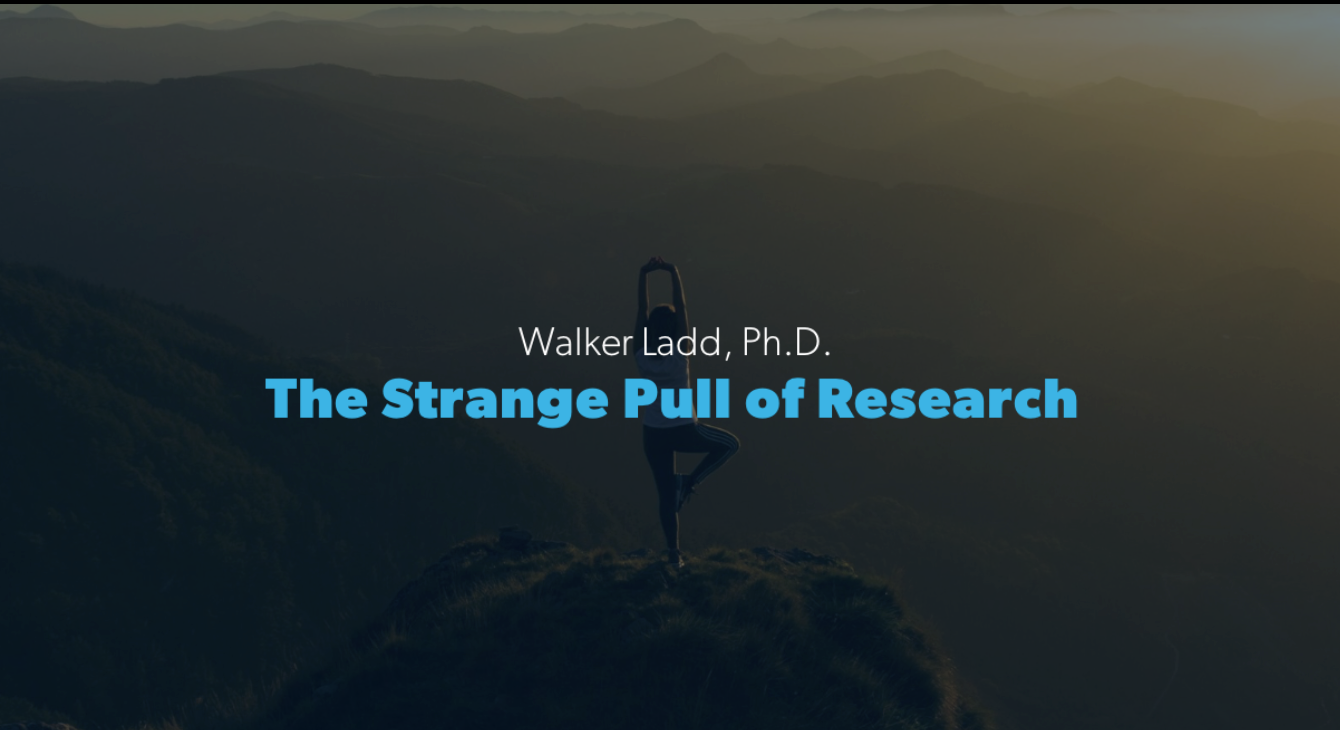By Walker Ladd, Ph.D.
"Let yourself be silently drawn by the strange pull of what you really love. It will not lead you astray." — Rumi.
Many students are called to pursue a doctorate because of an experience that has impacted their lives, personally or professionally, often both. The experience gives birth to a courageous curiosity that refuses to simmer down. Conducting dissertation research can ignite this curiosity and result in profound personal and scholarly transformation. Yet, at first, there is a lot of work to clear away the cobwebs of preconceptions, schemas, and heuristics we carry about “research.”
When I started my Ph.D. in psychology, I could not imagine that research would be transformational. Like most students, I had never conducted research, but I had been told versions of what it was. My beliefs about research were shaped by intersecting social, cultural, and personal constructs of academia and nagging uncertainty about my scholarly abilities. Entering the academy, I thought research was a tiresome chore unrelated to my interests or a litmus test for a doctorate versus a vehicle for personal transformation. Indeed, I hadn’t learned yet that doing graduate research is different.
Recent findings by a team of library science researchers using qualitative methods determined that graduate students may perceive research as an abstract concept and a personal odyssey occurring over time on an emotional continuum. The authors suggest that “graduate students have an experience of research distinct from other populations” that “transcend disciplinary boundaries.” This uniquely powerful experience can cause personal transformation for graduate students.
In “Transforming Self and Others Through Research,” transpersonal researchers Rosemarie Anderson and William Braud describe transformation for a researcher as “a persistent, pervasive, and profound shift in one’s life view.” They suggest three components of transformational potential when conducting research:
- The project has meaning.
- The method allows for multiple ways of knowing.
- Researcher preparation for missing skills.
To access these components, I suggest the following practices for connecting with your topic and curating your curiosity.
Connecting With Topic: The Meaning of the Problem
Connecting with the topic involves understanding how and why it has become known to us. In his landmark book, “The Wounded Researcher: Research With Soul in Mind,” Robert D. Romanyshyn noted, “The work that the researcher is called to do makes sense of the researcher as much as he or she makes sense of it. Indeed, before we understand the work we do, it stands under us.” Through ongoing reflexive practice, such as journaling, we can dig down into “what stands under us.” Connecting in this way creates a relationship with the topic; as such, we communicate with it, acknowledging it as an entity that needs to be questioned and considered. For example, consider journaling about your topic in the following way.
Connecting With Topic Exercise
Ask yourself questions that explore the topic's meaning to you personally and professionally:
- What brought me to this topic?
- What meaning does it have for me, personally or professionally?
- What unique perspective do I have?
Reflexive questions such as these can help uncover the topic's meaning, our relationship with it, and how it manifests as a problem that requires further research:
- How do others experience this topic?
- How does this topic create problems for others?
- Who is directly impacted by the problem? How do I know?
- Who is indirectly impacted by the problem? How do I know?
Early cognitive psychologist D.E. Berlyne considered this questioning a “thematic probe” that induces curiosity, wonder, and self-knowledge. For researchers, how we define or relate to our topic's problem reflects our philosophical paradigm—the lens through which we perceive the world, the nature of truth, reality, and values. Knowing this affords a deeper understanding of our affinities with research methods. Thus, asking questions invites curiosity and reveals a worldview integral to crafting the research question and choosing a method that allows for multiple ways of knowing and supporting transformative research. In this way, connecting with the topic creates opportunities to curate the call of curiosity.
Curating Curiosity: Finding the Research Question and Choosing the Method
In a 1955 Life magazine interview titled "Old Man's Advice to Youth: 'Never Lose a Holy Curiosity,’” Albert Einstein advised, “The important thing is not to stop questioning. Curiosity has its own reason for existence. One cannot help but be in awe when he contemplates the mysteries of eternity, of life, of the marvelous structure of reality. It is enough if one tries merely to comprehend a little of this mystery each day.”
As you continue to connect with your topic, exploring the problem at its roots and developing a research question, pay attention to what keeps you questioning and wondering about the mystery of the topic—specifically, what doesn’t seem right. Curiosity scholars such as George Loewenstein have identified that incongruity creates a powerful cognitive tension that fuels curiosity. In this space, we discover how our expectations of the problem, its causes, effects, and responsibilities are incongruous with the reality of it. Lean into it as you practice writing the core of a dissertation research project: the research question.
Creating a central research question that identifies the problem and how we will approach it methodologically is a puzzle. Like attempting a Rubik’s Cube, we shift, twist, turn, and flip the words to align with our research intentions. This research twister is a perfect opportunity to curate our curiosity. Curating curiosity involves paying attention to how your research question drives the method.
Curiosity Exercise
Examine the research literature about your topic and note the methods used. Ask yourself:
- What about this approach doesn’t work with my approach?
- What remains mysterious about the topic, the problem?
- What method would give me the data I need to answer my research question?
- What do I still want to know?
- What do I still need to know?
These questions will reveal what skills you need to be prepared for success. Curating curiosity through examination of methodological alignment with the research question provides insight into our skill set. Identify additional skills needed to use the method that best aligns with the research question. Seek guidance from research faculty to strategize acquiring the skills. Follow the strange pull of the research topic!
Concluding Considerations
Continue to explore the topic. Relate with it as a messenger of what work needs to be done and your unique position to address the problem at its core. When in doubt? Know that it will keep talking to you in a myriad of ways.
“But however small it was, it had, nevertheless, the mysterious property of its kind—put back in the mind, it became at once very exciting, and important; and as it darted and sank, and flashed hither and thither, set up such a wash and tumult of ideas that it was impossible to sit still.” — Virginia Woolf, “A Room of One’s Own”
Through your doctoral research, stay close to your relationship with the topic. It’s yours and unique to you. Curiosity is there, refusing to sit still. Research topics etch themselves into the fiber of our beings, incessantly tugging at our minds, asking us to do something, pushing beyond our current view of reality and our daily lives, and demanding our attention. Research pulls us out of ourselves.



























